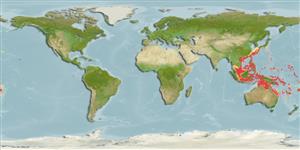Common names from other countries
Environment: milieu / climate zone / depth range / distribution range
Ekologi
Berasosiasi dengan karang; kisaran kedalaman 6 - 70 m (Ref. 8294). Tropical; 36°N - 28°S, 37°E - 137°W
Indo-West Pacific.
Length at first maturity / Size / Weight / umur
Maturity: Lm ? range ? - ? cm
Maximum depth from Ref. 115142. Occurs in most tropical reef habitats protected from strong wave action. Colonies inhabit shallow fore reef areas but are more common on slopes and overhangs (Ref. 98471). Has moderate bleaching level and moderate estimated mortality in Palau (Ref. 66144).
Life cycle and mating behavior
Kematangan | Reproduksi, perkembang biakan | Pemijahan | telur-telur | Fecundity | Larva
Hermaphroditic (Ref. 113712). Mature gametes are shed into the coelenteron and spawned through the mouth. Life cycle: The zygote develops into a planktonic planula larva. Metamorphosis begins with early morphogenesis of tentacles, septa and pharynx before larval settlement on the aboral end (Ref. 833).
rujukan utama
Acuan | Koordinator | mitra
Veron, J.E.N. 2000. (Ref. 847)
Status IUCN Red List (Ref. 130435)
status CITES (Ref. 108899)
Not Evaluated
penggunaan manusia
| FishSource |
Alat, peralatan
informasi lanjut
Umur / SaizPertumbuhanpanjang-beratpanjang-panjangMorfologiLarvaKelimpahan
Sumber internet
Estimates based on models
Preferred temperature
(Ref.
115969): 18.3 - 28.1, mean 25.3 (based on 597 cells).
kategori harga
Unknown.
